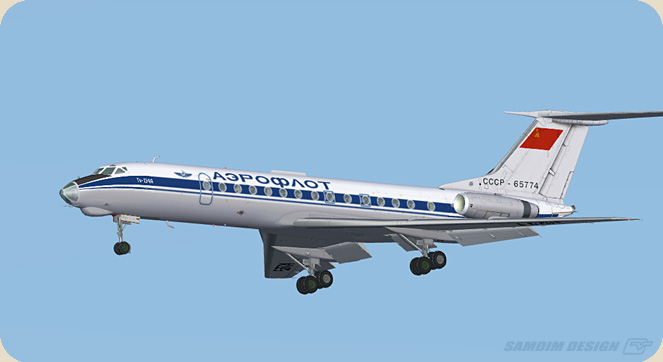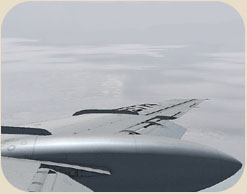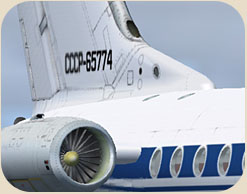|
For many years the Tupolev Tu-134 was the standard short haul jet airliner in the Soviet Union and eastern Europe.
The Tupolev design bureau was responsible for the Soviet Union's first jet powered airliner, the Tu-104
(which was based on the Tu-16 `Badger' bomber), and the Tu-104's smaller brother the Tu-124. Both of these
short range jetliners suffered from a number of performance shortfalls however, thus prompting development
of the Tu-134.
The initial Tu-134 design was based fairly closely on the Tu-124, and for a time was designated the Tu-124A.
However Tupolev decided to reconfigure the aircraft to feature rear fuselage mounted engines and a Ttail,
resulting in the new designation.
Six development Tu-134s were built, with the first flying during 1962. Production began in 1964 although
it was not until September 1967 that Aeroflot launched full commercial services.
Initial production was of the standard fuselage length Tu-134, while the stretched Tu-134A entered
Aeroflot service in the second half of 1970. Seating up to 76 in a single class, the Tu-134A differed
from the Tu-134 in having a 2.10m (6ft 11in) fuselage stretch, a reprofiled nose, more powerful D30
engines and an APU.
Other versions are the Tu-134B with a forward facing position for the third crew member between
and behind the pilots, the Tu-134B1 which has a revised interior to seat up to 90 passengers without
a galley, and the Tu-134B3 which can seat 96 with full galley and toilet facilities retained.
© Airliners.net
This add-on is in development. We plan to make four models of this family:
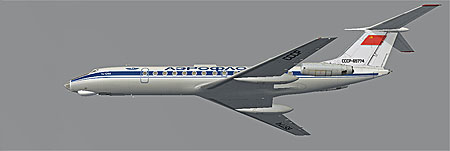 |
Tu-134-A The most popular version with glass navigator's place.
|
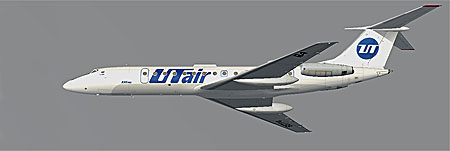 |
Tu-134-B The glass nose is replaced by a plastic one and hosts the weather radar.
Many of the Tu-134-A have also the plastic nose.
|
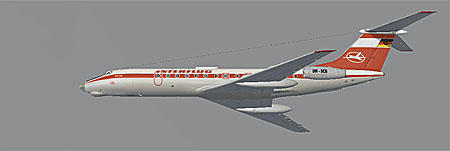 |
Tu-134-1 The first version of this plane. It has a shorter fuselage, has
neither thrust reversers nor spoilers, but instead - a breaking shield and a parachute.
|
 |
Tu-134 UBL Flying navigator's school. It has the nose of the Tu-22 bomber and some of its navigation equipment
|
Extremely detailed but still framerate friendly visual model - this difficult
compromise is achieved by using a reduced number of texture files (with very
dense mappings though), hiding unvisible parts and optimizing polygone count wherever
possible. Many animations are implemented: fowler flaps with pushers, alierons
and the rudder with compensators, elevators with trimmers - all the control
surfaces are power-dependent; spoilers, deployed only when they are unlocked
from the panel; completely animated main gears, the main gear wheel pairs roll
parallel to the ground independently on the plane's pitch; brake discs heat red
when the brakes are applied for some time at high speed; variable pitch stabilizer
- driven from the panel - with a real effect on the aircraft behaviour; the front
gear turns maximum to 55° or 8° dependent on the steering angle limitator; inertial
doors (with animated handles) that open/close normally when the aircraft is still,
but half-close or open when the aircraft is accelerating; thrust reversers inside
the engines are animated too; forward and rear landing lights deploy separately,
activated by separate switches; curtains in the passenger cabin close automatically
when the sun can be disturbing for the passengers; cabin windows and wipers
are animated; wipers actually do wipe; parking mode with engine caps and flags;
breaking parachute (on Tu-134-1) that quivers on wind at high speed, then falls
down when the plane stops; breaking shield (on Tu-134-1) with pushers; APU intake
doors; most of the switches and levers in the virtual cockpit are clickable/draggable;
most of the panels are operational in the virtual cockpit; in order to increase the framerate,
the passenger cabin is hidden when the cockpit door is closed;
|
